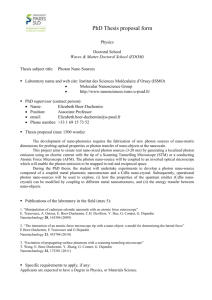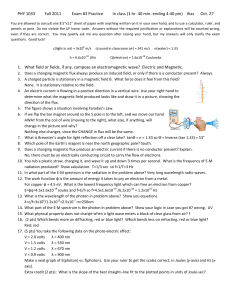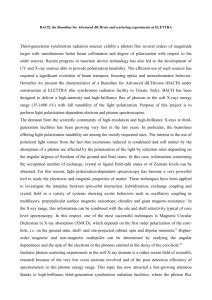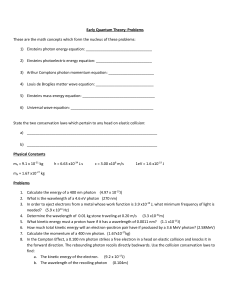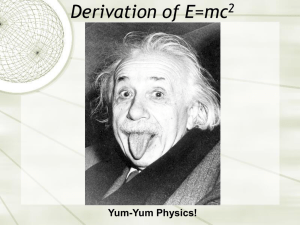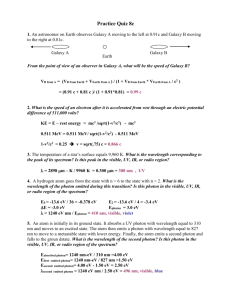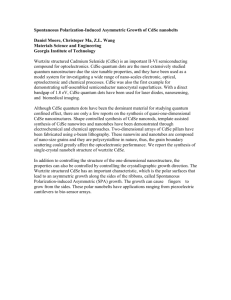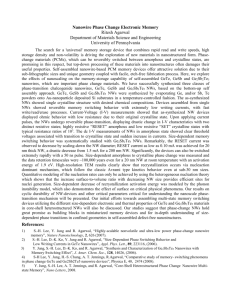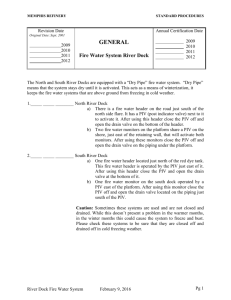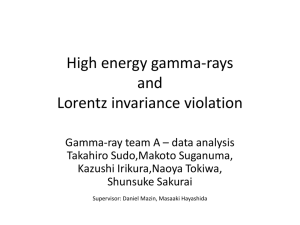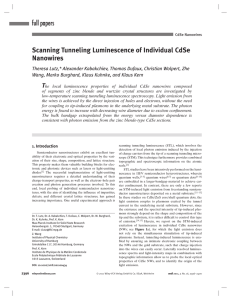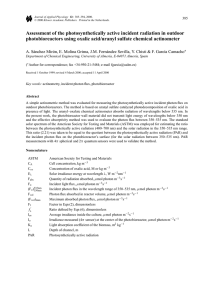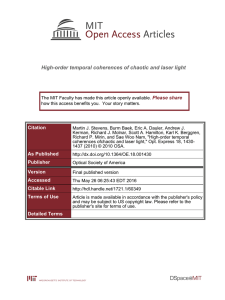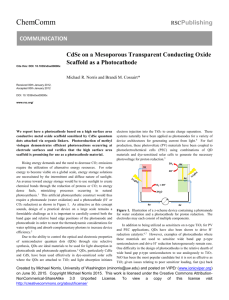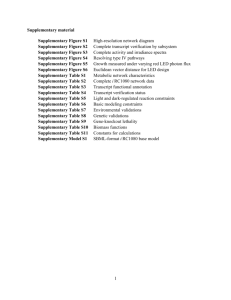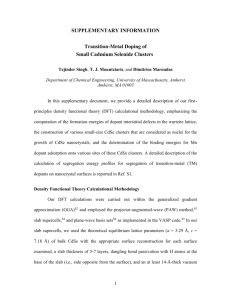Light-gated single CdSe nanowire transistor: Photocurrent
advertisement
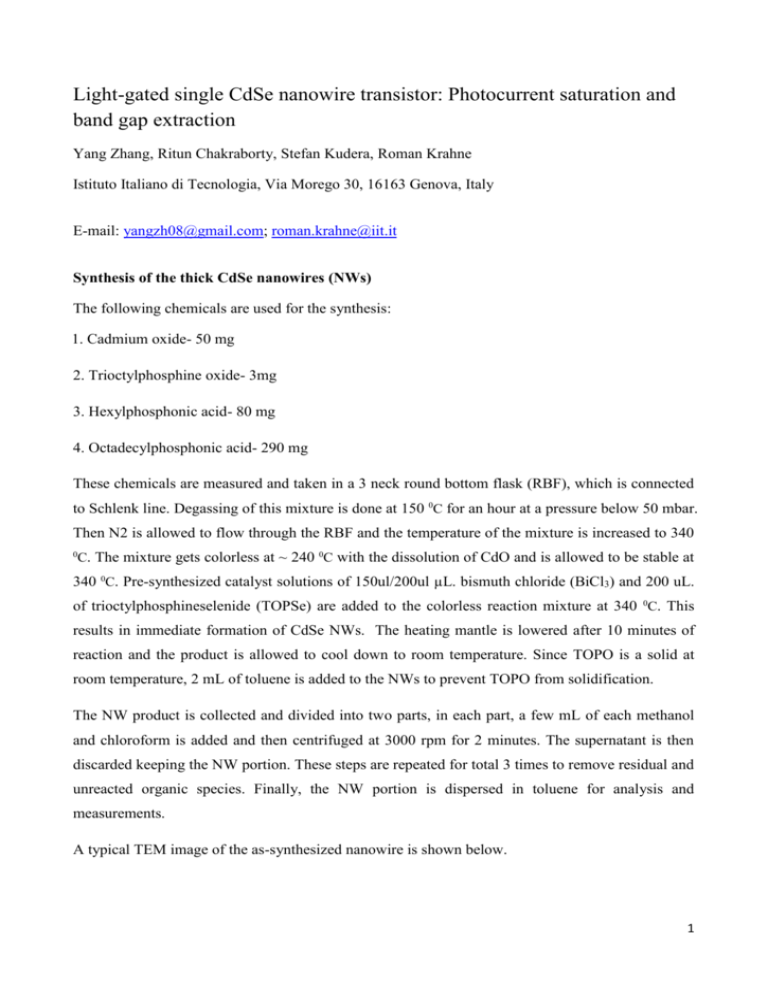
Light-gated single CdSe nanowire transistor: Photocurrent saturation and band gap extraction Yang Zhang, Ritun Chakraborty, Stefan Kudera, Roman Krahne Istituto Italiano di Tecnologia, Via Morego 30, 16163 Genova, Italy E-mail: yangzh08@gmail.com; roman.krahne@iit.it Synthesis of the thick CdSe nanowires (NWs) The following chemicals are used for the synthesis: 1. Cadmium oxide- 50 mg 2. Trioctylphosphine oxide- 3mg 3. Hexylphosphonic acid- 80 mg 4. Octadecylphosphonic acid- 290 mg These chemicals are measured and taken in a 3 neck round bottom flask (RBF), which is connected to Schlenk line. Degassing of this mixture is done at 150 0C for an hour at a pressure below 50 mbar. Then N2 is allowed to flow through the RBF and the temperature of the mixture is increased to 340 0 C. The mixture gets colorless at ~ 240 0C with the dissolution of CdO and is allowed to be stable at 340 0C. Pre-synthesized catalyst solutions of 150ul/200ul µL. bismuth chloride (BiCl3) and 200 uL. of trioctylphosphineselenide (TOPSe) are added to the colorless reaction mixture at 340 0C. This results in immediate formation of CdSe NWs. The heating mantle is lowered after 10 minutes of reaction and the product is allowed to cool down to room temperature. Since TOPO is a solid at room temperature, 2 mL of toluene is added to the NWs to prevent TOPO from solidification. The NW product is collected and divided into two parts, in each part, a few mL of each methanol and chloroform is added and then centrifuged at 3000 rpm for 2 minutes. The supernatant is then discarded keeping the NW portion. These steps are repeated for total 3 times to remove residual and unreacted organic species. Finally, the NW portion is dispersed in toluene for analysis and measurements. A typical TEM image of the as-synthesized nanowire is shown below. 1 Figure S1. Current-voltage characteristics of a second device (D3) recorded at various white light illumination intensities. The absolute value of the currents at negative voltage biases is plotted for the ease of comparison. 2 Figure S2. a) Dark current-voltage characteristics of the device discussed in the main text (D4). b) The linear fit to the dark current data depicted on a log-log plot. The fitted slope of the red line is ~2.36, which is a typical characteristic of space charge limited conduction. Figure S3. a) Extraction of the conductances from the PIV curves. The straight lines are the fits to the data. The extracted conductances are reported in Figure 2b in the main text. b) Extraction of the saturation voltages. The PIV curves at positive polarity are depicted on a semi-log plot. The intersections of the black horizontal lines with the PIV curves are taken as the saturation voltages. Evaluation of the primary photocurrent of D4 at 100% light intensity 1. Evaluation of the light power density of the microscope lamp The absolute light power 𝑃 is calculated from the following expression: 𝐼 𝑃 = 𝑅(𝜆) (𝑆1), 3 where 𝐼 is the current output from a Si photodiode when it is illuminated by the microscope light, and 𝑅(𝜆) is the wavelength-dependent responsivity of the Si photodiode. For the power calculation, we use an average responsivity of 0.35 A/W, which is estimated from the responsivity curve of the diode shown in the specification. We obtain a power of 0.37 mW when the Si diode is placed at the same distance away from the lamp as the sample stage surface. The power density (𝑃𝐷) is obtained by dividing the absolute power with the active area of the Si diode, and it is 46.3 mW/cm2. 2. Calculation of the photon flux The photon flux 𝜙 is calculated with the following expression: 𝜙= 𝑃𝐷 (𝑆2), ̅̅̅ ℎ𝜈 where ̅̅̅ ℎ𝜈 is the average photon energy of the microscope light, and it is estimated from the spectrum of the light to be 2.37 eV. The resultant photon flux at 100% light intensity is 1.22 × 1017 𝑠 −1 𝑐𝑚−2 . 3. Evaluation of the primary current The primary current is evaluated using Eq. (1) in the main text, that is, 𝐼𝑝𝑟 = 𝑒Φ = 𝑒ϕ𝑆 (𝑆3), where 𝑆 is the surface area of the nanowire, and it is 2.38 × 10−9 𝑐𝑚2 for D4. Substituting the values of the photon flux and the surface area into Eq. (S3), we obtain an 𝐼𝑝𝑟 of 46.4 pA. 4 Figure S4. Photoconductive gain of D4 as a function of relative light intensity. The relative light intensity of 1.0 corresponds to an absolute intensity of 46.3 mW/cm2. Figure S5. Photocurrents of D4 recorded at 18 K (red) and 300 K (black) under 100% white light illumination. 5 Figure S6. Normalized and averaged photoconductivity spectra of D4 (a-b) and D3 (c-d) at 300 K and 18 K. Figure S7. Semi-log plot of the spectra of D4 in the sub-bandgap region at 300 K (a) and 18 K (b) at different voltage biases. The arrows in b) and c) indicate the peak positions. 6
